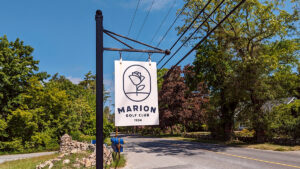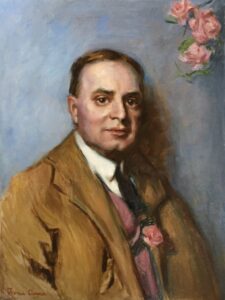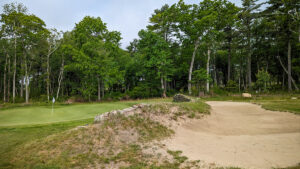By: Rich Rapp
rrapp@massgolf.org
Excellent, you’ve booked a tee time at a golf course designed by a world-renowned, U.S. Open course architect. You head down Point Road in Marion, Massachusetts, eyes seeking fairways and flagsticks. Suddenly, the trees peel away, and an immaculate greenscape lies glistening and low on the shores of Buzzards Bay.
Your heart skips a beat.
I have some good news and some bad news.
Though you have indeed arrived at a course designed (or at least co-designed) by a world-renowned, U.S. Open course architect, upon checking in, the staff will politely inform you that they do not, in-fact, offer public tee times at The Kittansett Club. It sounds like you missed the handsome little sign for Marion Golf Club, about three miles back up Point Road.
There are rough gems that the locals want to keep tucked away for themselves, and then there are the ones that the locals seem genuinely surprised that you’re interested in at all. “Little Marion,” as it is affectionately known, falls more in the latter category. Though, with a coveted slot on restoration it-man Gil Hanse’s to-do list, the relative anonymity may not last long.

This June, the Los Angeles Country Club’s North Course will host the U.S. Open for the first time. LACC North was designed by George C. Thomas, the mastermind of several of California’s most storied tracks, including Riviera and Bel-Air Country Clubs. Immaculate playgrounds for Hollywood’s most powerful players.
Far less exclusive, and some 3,000 miles to the east, sits Marion Golf Club, Thomas’ first design, and one of only three constructed outside of the Golden State. Thomas himself seemed baffled by the opportunity: “The first course I ever constructed by myself was for a small Club sponsored by William Bullivant, of Marion, Massachusetts. I have often wondered why he trusted me, and admired his sportsmanship in doing so.”

Thomas grew up in Philadelphia and was part of the “Philadelphia School” of golf course architecture, along with A.W. Tillinghast, William Flynn, Hugh Wilson, George Crump and William Fownes. However, after returning from World War I as a captain in the Army Air Service, Thomas moved to California, where he spent the rest of his life designing courses, raising English setters, and cultivating over 1,200 varieties of roses (hence Marion’s excellent logo–I dare you not to spend three times your greens fee on merch).
It’s tough to confirm many details as to how or why Bullivant hired a young man from Philadelphia who had never designed a course before, though it’s been suggested that Thomas was dating Bullivant’s daughter at the time. In any case, Thomas seized on the opportunity to experiment on the gently sloping, bayside canvas.
Comparing Marion to Los Angeles Country Club is a little bit like watching a double feature of Martin Scorsese’s Mean Streets and Goodfellas. There’s undeniably something special going on with the debut, even if there’s a lack of refinement and mastery compared to the later work. The irreverent experimentation of a budding auteur might just charm you to death.
And Little Marion oozes charm.
A visit to the pro shop feels like stepping into someone’s living room, with the first tee awaiting just off the back patio. The opener is a handshake hole, a trend that would continue in Thomas’ later work. A shade over 300 yards, the fairway offers a generous landing area which is perched above the green. The green is large and carved into the edge of the woods, a framing that invites you to fire down at the pin.
If one is a warm handshake, two impishly pulls back its hand and runs it through its hair. The fairway bends to the right at a 90° angle, restricting the tee ball to about 175 yards. Even if you place your ball in the fairway, you will find that a short stone wall and two trees stand guarding the entrance to the green. Oh, and once you manage to get over the wall and through the trees, the green is a small, severely sloped turtle back that’s just itching to repel your approach shot. Two is a fairy tale. Two is a level in Super Mario Brothers. Two wreaked havoc on my scorecard.
Three introduces the most unforgettable design aspect and one that probably wouldn’t have flown with a country club committee. Each of Marion’s three Par-3s are fronted by stone walls of varying heights—go ahead and leave that fancy laser range finder in your bag.

Are the stone walls a gimmick? Not in the least. Take it from someone who once had the good fortune(?) of navigating an abbreviated chip shot from the wall lining the Road Hole at St. Andrews. The walls predated the golf course and at their indeterminate age, can be taken as part of the land. The quintessentially New England land. Those walls are of a time and a place to the extent that the golf course is of a time and place.
After smothering you with trees and walls, Thomas spits you out into an open field—time to cut it loose. 4,5,6 and 7 alternate running down the slope towards the bay, then back up to the top, and down and up. Despite the pattern and the easy flow of the property, each hole during this stretch feels entirely unique from the others. The sixth green sits as close to the bay as any part of the property, and a gap in the trees reveals a confluence of masts bobbing atop the sparkling water.
Thomas’ ability to craft such unique holes on an unassuming piece of land is a testament to his creativity. “When you play a course and remember each hole, it has individuality and change. If your mind cannot recall the exact sequence of the holes, that course lacks the great assets of originality and diversity,” wrote Thomas in his seminal book, Golf Architecture in America: It’s Strategy and Construction.
Marion closes with two par-3s that are anything but short on individuality. 8 plays up the slope with a mid to long iron into another wall-guarded green. After a contemplative walk through the woods, the 9th barely spans more than the length of the clubhouse, reflecting Thomas’s assertion that “one shotters on any course should require not only different types of shots, but different lengths of shots.” Less than 125 yards down the slope to a punch bowl green may be a recipe for a hole-in-one, but you won’t know it from the tee, as a large bunker collides face-first into yet another stone wall. All you can see is the top of the flag, teasingly flitting about above the menacing lip.

The U.S. Open at LACC will be spectacular to watch, with holes winding through Southern California’s barrancas, salvaging a bit of natural landscape in the shadows of glassy skyscrapers. Another thrill to the serious golf fan will be the lack of previous public exposure to the course. Consider then, how unique it is that a loop around Little Marion will cost you $21 on a weekday, and tee times are readily available.
Though Thomas’ remaining courses largely require some serious connections to get a peek at, the man seemed to understand the value of public golf: “It is most important for the future of golf in this country that every aid should be given to the building and upkeep of Municipal courses, because such will eventually become of the greatest value to the game, and from them we may expect to produce many of our future great players.”
Take a ride down to Marion—enjoy the quirk, embrace the scruff, and make sure you have enough club to carry those stony walls.
♦
Mass Golf is a 501(c)3 non-profit organization that is dedicated to advancing golf in Massachusetts by building an engaged community around the sport.
With a community made up of over 110,000 golf enthusiasts and over 340 member clubs, Mass Golf is one of the largest state golf associations in the country. Members enjoy the benefits of handicapping, engaging golf content, course rating and scoring services along with the opportunity to compete in an array of events for golfers of all ages and abilities.
At the forefront of junior development, Mass Golf is proud to offer programming to youth in the state through First Tee Massachusetts and subsidized rounds of golf by way of Youth on Course.
For more news about Mass Golf, follow along on Facebook, Twitter, Instagram, and YouTube.